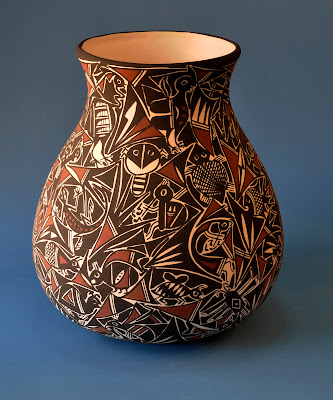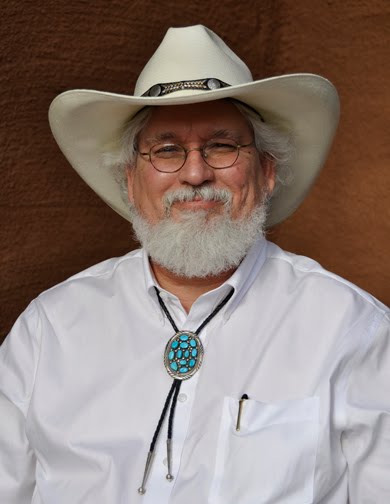Tuesday, November 13, 2012
Monday, November 12, 2012
Navajo Portrait Pendant 4
 |
This impressive portrait profile pendant depicts the head of a Navajo man dressed in ceremonial coyote costume, a practice still widely observed among the modern Navajo. The pelt riggings complete with coyote tails are often pawned when not needed then retrieved periodically for ceremonial use. The piece shown above is stamped "Calvin Begay" and "J Duboise" for John Duboise, the brother of the very accomplished micro-inlayer Norman Duboise who actually designed and placed the natural stone and tiny silver cuttings to create this unique work. The pendants from this portrait series represent some of the best pieces of Indian Jewelry I have ever seen.
Sunday, November 11, 2012
Saturday, November 10, 2012
Friday, November 9, 2012
Monument Valley Inspired Jewelry
Last month Sunrise Indian Jewelry of Gallup, New Mexico asked me to design a promotional postcard for them featuring these freshly minted micro-inlay bracelets inspired by the scenic views of the Monument Valley on the Utah-Arizona border. This spectacular real estate is part of the Navajo Reservations land and undoubtedly one of the world's most inspiring landscapes.
Sunday, October 28, 2012
Zuni Pueblo Pottery
 |
| Contemporary Lizard Applique Zuni Pot by Deldrick & Lorenda Cellicion |
Saturday, October 27, 2012
Micaceous Pots by George Garcia
Glittery flecks of mica are found in many natural clay deposits in the Rio Grande region of Northern New Mexico. This sparkling clay has been used by Native Americans of the region as far back as 1300 AD. When properly cured, mica vessels can be used for cooking, but are now more commonly collected as decor items readily recognized by their distinctive sheen. George Gonzales, a Native American potter from Northern New Mexico, says of his work, "With my hands I take my Mother Earth and give her shape. The heat from my Father, the sun, gives her life and the rainbow of my New Mexico sunset gives color to her child. Every piece I make is a piece not taken away but placed in my life and with the blessing of the Great Spirit I live. The clay tells you what it wants you to do with it.You create the shape with each coil. It is more personal when you make a pot that can sit on its own without any decoration. Then you have something."
Sunday, September 16, 2012
Navajo Portrait Pendant 1
 |
| Double Sided Navajo Pendant by Norman Duboise and Calvin Begay |
A few months ago I was approached and asked to submit a donation proposal to the National Museum of the American Indian section of the Smithsonian Institute. I cheerfully accepted the job after viewing the six magnificent pendants the donor had commissioned. All the pendants are a collaborative product of two Navajo artists: silversmith Calvin Begay who is widely known; the other artist, Norman Duboise, is a rather obscure master inlayer who lives out on the immense Navajo Reservation in an area close to the New Mexico-Arizona border where he enjoys tending to livestock and living in the traditional Navajo way. His work in the jewelry business began at age 14 when he was hired by Frank Yellowhorse as a buffer. Neither artist had previously been represented in the Smithsonian collection, a point that heightened my interest.
I recommended that all six of the pendants be submitted for review, but that the selection be limited to one choice. The whole process lasted about 4 months beyond the time I submitted a written proposal along with digital photographs. Finally, the curatorial committee selected one of the pendants and forwarded their recommendation to the museum director who made the final approval.
I was a bit surprised last week when the donor asked me to represent the sale of the five remaining brilliant Navajo masterworks.
Friday, September 14, 2012
Sunday, July 29, 2012
Santa Fe Spanish Market
Neuvomexicano art, deeply rooted in the Spanish Colonial years of New Mexico of the late 14th century, is impressively showcased at the annual Spanish Market in Santa Fe, New Mexico. Although some of the art work is secular, the religious expression is highly dominate and most often represented by carved bultos (statues of saints), wooden crucifixes, reredoses (altar screens), retablos (paintings), and various tin and metal creations.
Sandy and I attended the impressive annual market this weekend. The half-gallon micaceous bean cooking pot shown below by Vilis and Brenda from the Dragon Star Studio in El Cerro Mission, New Mexico is one of the items we brought back. Sandy initiated it on the stove top last night by cooking up a batch of saffron accented white rice.
Saturday, July 28, 2012
Wi-Cahpe-Luza
Tuesday, July 24, 2012
Johnson Duboise - Navajo Inlay Artist
This pendant is the type of treasure I love to find. It gives me a picture opportunity to promote an unknown or scarcely known artist of great merit. Jewelry aficionados, especially upon knowing that the work is of exclusive Navajo origin, will likely recognize the silver craft design of excellence by Calvin Begay. Although the back of the piece along with the silver casing is attractive, the real appeal is the micro-inlay of jasper, mother of pearl, lab opal, Acoma jet, and tiny bits of round sterling wire slivers. The whole pendant measures 1 7/8 inches in length. The small bale is not roomy enough in its interior dimension for the artist's imprint so it is not a hallmarked work; nonetheless, the collaborative piece is a product of Sunrise Indian Jewelry in Gallup, New Mexico which is, I believe, the crème de la crème of the Native American jewelry manufacturing houses that encourage, train, and bring artists together. Authentic Native American art is all too often copied and sold as a markedly inferior product, so it is worthwhile to inquire about provenance when considering a purchase. The pendant above is worth about $500.
Monday, July 16, 2012
Berleen Estevan Acoma Pottery
Berleen Estevan's Grandmother taught her the art of traditional pottery making as a child. She, like many pottery artisans of the Acoma Pueblo, works with both traditionally hand coiled pots and with greenware. The ceramic greenware pot illustrated above shows her characteristic elaborate and detailed painting style.
Saturday, July 14, 2012
Sunday, July 1, 2012
Promoting New Mexico
I have obviously started a new project of designing posters promoting not only artists, but also the Southwest USA with emphasis on my home state of New Mexico. A few years ago I was a contributing photographer for the New Mexico Office of Cultural Affairs and New Mexico Magazine. Perhaps, I'll start anew.
Subscribe to:
Comments (Atom)














